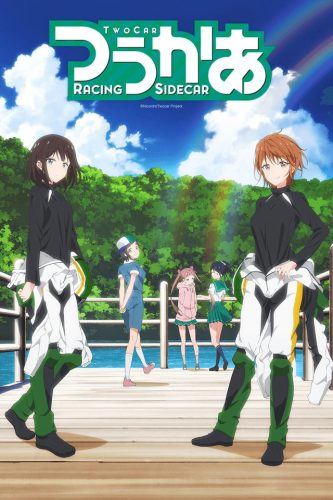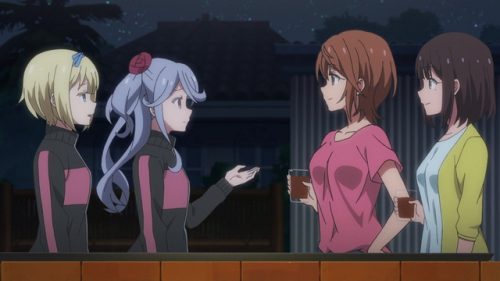
Two Girls, One Bike
- Episodes : 12
- Genre : Sports
- Airing Date : October 2017 – December 2017
- Studios : Silver Link
Contains Spoilers
Miyata Yuri and Meguro Megumi have a dream: to win their island’s kneeler racing tournament for the eligibility to enter the Isle of Man international competition in the UK! Why? Because they’re both in love with their former coach, Tanahashi. Unfortunately, if they want to compete for his affection, they’ll have to work together temporarily. Kneeler racing requires two riders: a driver to steer and a passenger to distribute balance, and they happen to work well together. Can they succeed in putting their differences aside for the chance to be with their beloved Tanahashi?
While the above is the overall plot, Two Car bounces around from story to story, focusing on the trials and tribulations of Yuri and Megumi’s opponents. You’ll learn about the friendship between Nagai Misaki and Shiohara Chiyuki that transcends social positions, the dominant and submissive bond between Murata Izumi and Suzuki Nagisa, the inseparable twins Yuria and Maria, and even a quick story about kneeler racing’s favorite announcers, Makita Ai and Itagaki Nene. Interspliced between these stories are quick asides about Two Car’s favorite couple, Katakura Mao and Iseki Hitomi, and how they learn about their perfect relationship, which may not be as ideal as it seems.
Two Car ends with Yuri and Megumi attempting to break up Tanahashi and his fiancée Betty Birtual, Yuri and Megumi’s former hero. During a time trial race, Megumi falls off the kneeler and breaks her leg, forcing Yuri and Megumi to switch positions in the determining race. While initially they do quite poorly, a freak storm forces the rest of their opponents to slow down while Yuri and Megumi are able to catch up and win. Betty then confronts Tanahashi after realizing Yuri and Megumi were right about Tanahashi being wrong for her, leaving Yuri and Megumi free to pursue Tanahashi.
The few races that are sprinkled throughout Two Car are well animated. There are some notable, off-putting instances of CGI mixed in during a few episodes, but for the most part, the races are suitably zippy and can be enjoyable to watch. It forgoes a lot of lengthy explanations of techniques used and largely keeps its focus on the pure adrenaline rush of an explosive race. Kneelers blast through the rain, slice around corners with cutting precision, and it captures a sense of momentum and speed through the quick camera work. At the very least, you won’t be disappointed whenever a race comes up.
Two Car is a strange, confusing show. The overall focus of the show is pretty clear: it’s about following the relationships between the different sets of girls as a thinly veiled excuse to ogle them. Every pairing follows a common framing device for just about every kind of yuri fetish you can think of: there’s the wealthy girl/working class duo in Chiyuki and Mizuki, the twins who obsess over being similar in Yuria and Maria, the sadomasochist pairing of Izumi and Nagisa, and so forth. Two Car tries to give everyone some screen time so that anyone who just happened to like a pairing will be happy to see them get their due… except around episode 9, where Two Car dumps its own formula and refocuses on Yuri and Megumi’s desire to score with Tanahashi.
Maybe this dilly dallying with the main plot would be more palatable if the time spent leading up to it were used to build up its central characters throughout each of these stories, but ultimately, each new story passes by only to be completely forgotten by the next set of episodes. There’s no sense of growth to any of the characters because everything resolves by stating that the status quo before was fine. This seems like it’s due less to a sincere message of stating that you’re fine as you are and more that the writers seem afraid of pushing the viewers out of their comfort zones. The girls are there for your enjoyment, so why should they evolve as people? You only like them because you have a kink for twins or dominant-submissive relationships. Why challenge that?

1. Okay Art Design
The characters are not unattractive. There’s nothing particularly offensive or off-putting about any of the cast that would turn anyone off, so if you haven’t had your fill of cheesecake, by all means. You’ll be rewarded with copious shots of shapely butts in bodysuits. If you’re not a butt guy, then you still have an average of one hot springs sequence per episode to look forward to(this is not an exaggeration). If that’s your thing, then enjoy.
And at least it doesn’t get in the way of the races too much. You’ll get your rear view camera angles during the races, but honestly, if you don’t generally pay attention to pandering, then it won’t be that distracting, as the camera frames their figures off to the side more often than not so it’s not immediately obvious what Two Car is up to. Kneeler racing is at least a unique sport that no anime has made its subject matter, so you might glean something from watching the competitions.
1. Yuri and Megumi
Watching these two bicker with one another isn’t a charming insight into the struggles of maintaining a partnership as a youth. It’s more of a reminder of the sheer pettiness of adolescence. In episode 11, they tell Betty Birtuall that Tanahashi is an awful person and that she should break up with him. You think that this is going to be the moment where the girls are finally put in their place and realize how much their obsession with Tanahashi is stealing their focus away from their true passion. And, to Two Car’s credit, the show almost does this up until the last few minutes where Betty breaks up with Tanahashi for almost no reason. Yuri and Megumi are rewarded for their moment of blatant sociopathy without any consequence. This is not a reflection of the innocence of a youthful, naïve crush on an elder; this is idolizing and fetishizing a completely unhealthy relationship. They make Two Car as a whole uncomfortable to watch.
But it’s not as if Yuri and Megumi were particularly likeable before this. Most of their squabbles are frustrating because of how needlessly contentious they are. It’s not really funny that Megumi and Yuri are passive-aggressively getting back at one another by eating the other’s snacks because nothing is ever established for either one to make them at all sympathetic. Our sole insight into both characters is their shared love for Tanahashi in the first episode, and that is it. That is a detail of their history, not a character trait, and yet Two Car wants us to accept that as both girls’ defining feature.
2. Needlessly Confusing and Drawn Out Timeline

Around episode 9, there’s a revelation that the first episode was in the future and places a renewed focus on Yuri and Megumi. It’s revealed that reason the two were so particularly contentious in this one race is because Coach Tanahashi had come to watch them. This might have been an interesting twist, but there’s no connection between anything we saw up until this point and how the events of the first episode play out. It’s not like in these first episodes we saw Yuri and Megumi work together as friends, or we saw their deteriorating relationship due to their competing with one another over Tanahashi. We know about their entire backstory right from the first episode.
Which leads to the question of why even spend any time on these other racers if their stories didn’t add up to anything? It defies its own formula and we never get a story about the Osaka pair or, even more shockingly, the goth Lolita pair. It’s as if the writers of the show only had a vague plot in mind for Yuri and Megumi that was only worth about three episodes of content, and in order to stall for time, they used the twist of the first episode more as a weak crutch to justify wasting so much time on all these other characters. There was nothing we gained from revisiting why, for example, Chiyuki was afraid of taking a sharp turn, which helped Yuri and Megumi take the lead. It’s the animation equivalent of a student rushing to get a school report finished by the due date and slightly increasing the margins and font size to hit an arbitrary page limit; they clearly didn’t know what they wanted to do, so this framing gave them an excuse to draw out the length by reusing animation.
3. Poor Messaging
Let’s just forget for a moment about our heroines getting away with breaking up a perfectly healthy and normal relationship completely scot-free. Can we point out that Tanahashi is in his 20s while Yuri and Megumi are still in high school? There’s something insidious about how, after all the terrible actions that the heroes have taken throughout the course of the show, we’re seriously supposed to still be rooting for them by the end. Tanahashi’s adult break-up is their reward for realizing that they had become too focused on trying to woo a grown man. Since most of the show is spent ogling its female cast, Tanahashi seems to be the stand-in for its assumed male demographic. We cheer for these two because we’re supposed to desire them, and look, we know they’re cartoons, so no harm, no foul, but there’s something gross wanting us to root for the successful seduction of an adult by two girls who are still mastering algebra.
4. Lack of Character Growth

Yuria and Maria decide they want to distinguish themselves from one another, only to find that once they develop their own independence, the duo can no longer function as a kneeler racing team. So, to correct this… they have to revert back to being the same person. Or how about Izumi and Nagisa, where Izumi goes so far as punching Nagisa for even daring to question the healthiness of their relationship, only to freak out about how she could have died on the race track without Nagisa’s input. Only to… go back to being Nagisa’s overly dominant master, and so forth.
These are not stories that are interesting because they are not stories about people. These characters feel like they were designed by a committee, all for the sole function of selling cheap merchandise quickly to people who might just have happened to have latched onto the series because they saw a character design they liked. They’re less like characters and more like mascots who have to stay within their pre-defined personality trait, lest they devalue the brand and potentially turn off a customer who might want a Yuria or Izumi keychain.
Two Car is like clicking on a random recommended YouTube video based on a sexy thumbnail image and a lack of judgement. You tell yourself you’re watching because, hey, the concept of the video sounded interesting and there might be something more going on, but you know deep in your heart why you clicked. Like that random YouTube video, Two Car was designed to fill space in an endless void of content that the creators justify as an attempt to make a name for themselves. Don’t be fooled; there is nothing of value to be gleaned from Two Car. There’s no plot, no focus, no drive to anything that’s actually happening. It’s all a façade to trap the occasional man based on their primal instinct to look at boobs.
Disagree? Please, let us know in the comments below!


No comments:
Post a Comment